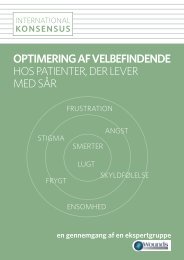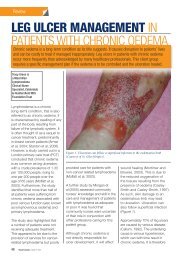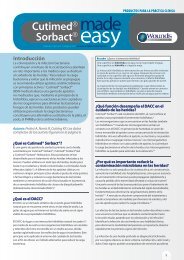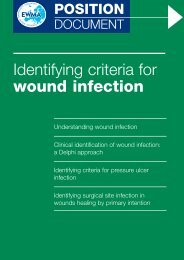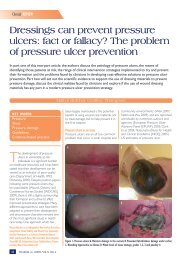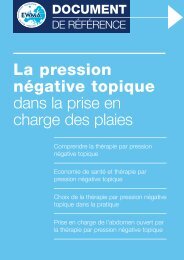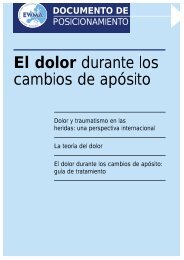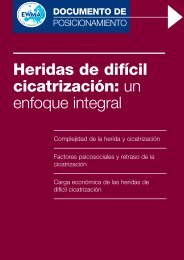VIEW PDF - Wounds UK
VIEW PDF - Wounds UK
VIEW PDF - Wounds UK
Create successful ePaper yourself
Turn your PDF publications into a flip-book with our unique Google optimized e-Paper software.
Clinical PRACTICE DEVELOPMENTDoppler and ABPI or LOI inscreening for arterial diseaseDoppler ultrasound is frequently used as a screening tool when assessing patients for arterial disease.The use of Doppler ultrasound to calculate the ankle brachial pressure index (ABPI) has been tested forreliability and reproducibility and has been found to be an accurate technique when used regularly byappropriately trained practitioners. An alternative to Doppler has been suggested using pulse oximetryto calculate the Lanarkshire Oximetry Index (LOI), which has been described as a feasible alternative toABPI. This article compares the techniques and discusses the implications for practice.Kathryn Vowden, Peter VowdenKEY WORDSDopplerABPILOIArterial assessmentLeg ulcerationThe assessment and monitoringof peripheral arterial diseaseis not only a fundamental skillrequired for all health care professionalsconcerned with the management ofpatients with lower limb ulceration,but it is also a necessary componentin the management of any patientwith suspected lower limb ischaemicsymptoms. As such, primary care staffrequire the skills necessary to conductsuch a procedure as they will oftenbe required to carry out the initialpatient assessment.To date, the gold standard for suchscreening has centred on the use of thehand-held continuous wave Dopplerultrasound and the measurement ofKathryn Vowden is Nurse Consultant, Bradford TeachingHospitals NHS Foundation Trust and University of Bradford;Professor Peter Vowden is Consultant Vascular Surgeon,Bradford Teaching Hospitals NHS Foundation Trust andVisiting Professor of Wound Healing Research, University ofBradford, Bradfordankle systolic blood pressure fromwhich the ankle brachial pressure index(ABPI) can be derived.An alternative technique, usingpulse oximetry to calculate theLanarkshire Oximetry Index (LOI),has been described as a method ofassessing if patients with lower limbvenous ulceration are suitable forcompression therapy (Bianchi, 2005). Ithas been suggested that the rationalefor introducing a change in practice isthat community staff have difficulty inperforming assessments using Doppler(Bianchi et al, 2000; Bianchi, 2005). IsDoppler ultrasound in fact too difficultto use or does this indicate that there isa deficiency in training, competence andservice delivery?Certainly the authors’ experience ina secondary care specialist unit wouldindicate that the use of Doppler is nota difficult skill to acquire with trainingand regular practice. The technique hasroutinely been applied for a numberof years as part of the assessmentof patients with possible peripheralarterial disease.With the increasing emphasis onprimary care screening, early diagnosisand detection of disease, the roleof vascular assessment will moveprogressively to a primary care setting.Nurses are ideally placed to take onthis role and should have no difficultyapplying Doppler ultrasound techniquesas the basic examination is easilyundertaken and Doppler equipment isnow widely available.Doppler ultrasound and ABPIThe Doppler principle, first describedin 1842, relates the frequency of asource to its velocity related to anobserver. The principle was first appliedin medicine by Satomura in 1957(Satomura, 1957; Yao, 1970) to studyheart structure and function and wasdeveloped to allow examination ofblood flow in peripheral arteries. In1950, Winsor noted the differencebetween arm and ankle bloodpressures (Winsor, 1950), and Hocken,using a stethoscope and Korotcowsounds, found that comparison ofarm and ankle pressures was a usefulindicator of arterial disease (Hocken,1967). However, it was not until Yaoet al (1968) reported using Dopplerultrasound to record arterial bloodflow that the method became widelyapplicable.The method for carrying out anarterial assessment and deriving anABPI has not changed significantlysince its initial description other thanthe introduction of modern Dopplerequipment. The basic method is setout in Table 1. Using this technique,Yao and others (Sumner, 1989) were<strong>Wounds</strong> <strong>UK</strong>, 2006,Vol 2, No 113
Clinical PRACTICE DEVELOPMENTTable 1.Method for Doppler peripheral arterial pressure measurement and Ankle Brachial Pressure Index (ABPI)calculation (Vowden et al, 1996)Explain the procedure, reassure the patient and ensure that he/she is lying flat and iscomfortable, relaxed and adequately rested with no pressure on the proximal vessels1. Measure the brachial systolic blood pressure:8Place an appropriately sized cuff around the upper arm8Ensure that the equipment and the arm are at heart level8Locate the brachial pulse and apply ultrasound contact gel8Angle the Doppler probe at 45degrees and move the probe to obtainthe best signal8Inflate the cuff until the signal is abolished then deflate the cuff slowly andrecord the pressure at which the signal returns, being careful not to movethe probe from the line of the artery8Repeat the procedure for the other arm8Use the higher of the two values as the best non-invasive estimate ofcentral systolic pressure and use this figure to calculate the anklebrachial pressure index (ABPI)2. Measure the ankle systolic pressure:8Place an appropriately sized cuff around the ankle immediately above themalleoli having first protected any ulcer or fragile skin that may be present8Examine the foot, locating the dorsalis pedis pulse and apply contact gel8Continue as for the brachial pressure, recording this pressure in the sameway again with limb and sphygmomanometer at heart level8Repeat this for the posterior tibial and if required the peroneal andanterior tibial arteries8Use the highest reading obtained to calculate the ABPI for that leg8Repeat for the other leg8Calculate the ABPI for each leg using the formula below or look upthe ABPI using a reference chartABPI = Highest pressure recorded at the ankle for that leg/Highest brachial pressure obtained for both armsABPI normally > 1.0ABPI < 0.92 indicates arterial diseaseABPI > 0.5 and < 0.9 can be associated with claudication and if symptoms warrant,a patient should be referred for further assessmentABPI 1.00, with an ABPI of 0.92generally being regarded as the cut-offfor normal.Carter (1969) emphasisedthat meticulous attention to detailis necessary to obtain valid andreproducible measurements. A lackof awareness of the limitations ofthe ABPI and a failure to utilise allthe information obtained can lead toconflicting results and misinterpretationof the data. These issues have beenreviewed by Vowden and Vowden(2001). For example, even though thecalculation method may give an ABPIof 1.00 it does not mean that arterialdisease is not present. A pressuredifference of 15mmHg or morebetween vessels at the ankle indicatesproximal disease in the vessel with thelower pressure. This could be relevantwhen assessing the potential risk ofbandage pressure damage or assessingcardiovascular risk.Bianchi (2005) has highlighted anumber of concerns over performingDoppler evaluations. These are:8Perceived problems in locating footpulses which should be overcome bytraining and basic knowledgeof anatomy8Cited difficulties associated withthe probe angle and maintainingthe position of the probe overthe artery. These issues have beenlargely overcome by recent designmodifications to the Doppler whichnow incorporates a wider probehead and a moulded surface whichhelps users to maintain the correctprobe angle. For simple pressuremeasurement, probe angle is not asimportant as the signal itself, and isnot subject to analysis. However, theprobe angle is relevant when moredetailed analysis of the signal, suchas waveform analysis, is required.Probe angle will also affect thesound characteristics and thereforea good technique will aid the overallassessment process although it mayhave little effect on simple pressuremeasurement8All techniques measuring systolicpressure require the patient to beappropriately positioned with thelimb to be assessed at heart level.This is no different if Doppler orpulse oximetry is used to measuresystolic pressure; in both casesthe patient needs to be supine.Experience, and with it increasingskill, overcomes problems relatedto limb laterality cited by Fowkeset al (1988)8Extremities of both hyper- andhypotension impact directly on14 <strong>Wounds</strong> <strong>UK</strong>, 2006,Vol 2, No 1
Clinical PRACTICE DEVELOPMENTthe accuracy of non-invasivemeasurements of peripheralsystolic pressure and will effect theaccuracy of both ABPI and LOIcalculations (Carser, 2001). Theimpact of this is likely to be small,however, particularly in the rangeABPI 0.8 to 1.0.8Assessment of patients with severearterial disease may be difficultas detection of blood flow, andtherefore pressure, is difficultno matter which measurementtechnique is used. Patients withan ABPI of 0.8 or higher should,however, have a good strongsignal which should be easilyobtained. Patients with leg ulcersand pressures below these levelsshould be referred to a specialistcentre in line with guidelines (RoyalCollege of Nursing [RCN], 1998;Scottish Intercollegiate GuidelinesNetwork [SIGN], 1998). Variationsof up to10% in ABPI are of somerelevance in research studies orborderline cases but in clinicalpractice and in epidemiologicalstudies, a single assessment isacceptable (Fowkes et al, 1988)8The presence of oedema andlymphoedema can compromisepressure measurements, irrespectiveof the technique used. To minimisethis, the correct cuff size selection isrequired. Use of alternative Dopplerprobes, such as a 5 rather than an 8MHz probe will improve the depthof ultrasound penetration and aidvessel detection.The authors agree that Dopplerskills need to be enhanced. Thistechnique is necessary, not just forthe management of patients withvenous leg ulceration but also as partof the assessment of any patient withpotential peripheral vascular disease.Indeed it has been shown that thereis a direct relationship between ABPIand cardiovascular risk (Ogren et al,1993) indicating that this test shouldbe actively applied as part of cardiacassessment in primary care.The concerns raised by Bianchi(2005) are, therefore, mainly relatedto operative skill and experiencethat should be overcome by trainingand practice. Rather than lookingfor an alternative to this method ofassessment, healthcare professionalsshould increase their use of thehand-held Doppler to allow morewidespread application of this screeningtest for peripheral vascular disease.The authors agree thatDoppler skills need to beenhanced. This technique isnecessary, not just for themanagement of patientswith venous leg ulcerationbut also as part of theassessment of any patientwith potential peripheralvascular disease.Pulse oximetry and LOIBianchi (2005) has reviewed thedevelopment of pulse oximetry fromthe early reports of the measurementof oxygen consumption usingspectroscopy in 1874. Much of theinitial work using pulse oximetrycentred on its use in anaesthetics andemergency medicine. More recentlyit has been recognised that the pulseoximeter can detect tissue perfusion(Joyce et al, 1990), peripheral arterialdisease by reactive hyperaemic testing,(Couse et al, 1994) and arterialocclusion pressure.Jawahar et al (1997) found thatpulse oximetry was not a goodmethod of detecting early peripheralarterial disease, which raises questionsover the use of the technique inthe venous leg ulcer population.Johansson et al (2002) found that toesystolic pressures could be recordedaccurately, however, this is a differenttechnique for LOI to that describedby Bianchi (2005). Johansson’spaper confirmed the advantage oftoe systolic pressure measurement,whether by photoplethysmography,strain gauge, oximetry or Doppler,in the assessment of some patientswith diabetes. True toe systolicpressure has been related to footulcer healing in the patient withdiabetes (Carter, 1993).Bianchi has suggested that thismethod of assessing peripheral arterialdisease by measuring systolic pressureusing a pulse oximetry probe may beof value in assessing patient suitabilityfor compression therapy for lower limbvenous ulceration (Bianchi et al, 2000;Bianchi and Douglas, 2002; Bianchi,2005).In the technique described in theLOI, the blood pressure cuff is placedaround the ankle in the same positionas used for Doppler ankle systolicpressure measurement (Bianchi, 2005).As the pressure recorded is at thesite of the cuff and not the site of theprobe, this technique measures theankle systolic pressure and not the toepressure as implied by the calculationmethods. As such it suffers from thesame limitations as ABPI calculationsand has the same potential forinaccuracy in the presence of vascularcalcification and medial sclerosis. Theseinaccuracies may actually be increasedKey Points8 Vascular assessment is not justa number but an integrationof clinical signs, symptoms andinvestigation results.8 Doppler arterial assessmentand ABPI provide moreinformation on vascular statusthan LOI.8 LOI is subject to many ofthe difficulties and potentialinaccuracies caused byvascular disease that applyto ABPI assessment andis not a replacement for acomprehensive Dopplerassessment of the peripheralcirculation.8 Demand within primary carefor general cardiovascularand peripheral vascular riskassessment will increase use ofDoppler and, therefore, skill inABPI measurement.<strong>Wounds</strong> <strong>UK</strong>, 2006,Vol 2, No 115
Clinical PRACTICE DEVELOPMENTas there is the potential for diseasein the foot vessels to further bias theresults. The recommendation for allpressure measurement techniques is toplace the detector as close to the siteof vessel compression as is possible.Other potential problems that havebeen highlighted (Bianchi, 2005) withthe LOI technique include:8Thickened or trophic toe nails8Peripheral cyanosis8Digital vasospasm (Raynaud’sphenomenon)8Localised and well collateralisedperipheral vascular disease.A further disadvantage of usingthis technique from the patient’sperspective is that the ankle cuffremains inflated for a longer periodof time potentially causing increaseddiscomfort and pain. Anotherfundamental disadvantage is thatalthough the technique may give anindication of limb perfusion, it givesno information on the status of theindividual crural vessels.As with all techniques for measuringblood pressures, patient positioning isimportant if reliable and reproduciblereadings are to be obtained. Thecorrect cuff size and position mustbe selected but problems will stillarise due to abnormal limb size andnon-compressible vessels since theseare factors related to the cuff andcompression and not to the method ofblood flow detection.Equipment availability andmaintenance are also potentialproblems for both techniques, however,given the significant increase in theavailability of Doppler equipmentsince the RCN and SIGN guidelineswere published, accessibility should nolonger be a problem (Royal College ofNursing, 1998; Scottish IntercollegiateGuidelines Network, 1998).ConclusionLOI provides a method of monitoringpatients during treatment withcompression therapy but should notbe seen as a replacement for thehand-held continuous wave Dopplerand ABPI during the initial assessment16 <strong>Wounds</strong> <strong>UK</strong>, 2006,Vol 2, No 1of a patient with lower limb ulcerationor potential peripheral vasculardisease. Whichever method of arterialassessment is applied, and the authorswould continue to favour the use ofDoppler ABPI, it should, however, beremembered that the use of Dopplersupports the overall diagnostic andmanagement strategy. Results shouldnot be used in isolation but as partof the overall holistic patientassessment process. W<strong>UK</strong>LOI provides a methodof monitoring patientsduring treatment withcompression therapy butshould not be seen as areplacement for...Dopplerand ABPI during the initialassessment of a patientwith lower limb ulcerationor potential peripheralvascular disease.ReferencesBianchi J (2005) LOI: an alternative toDoppler in leg ulcer patients. <strong>Wounds</strong> <strong>UK</strong>1(1): 80–5Bianchi J, Douglas S (2002) Pulse oximetryvascular assessment in patients with legulcers. Br J Community Nurs 7 (9 Suppl): 22–8Bianchi J, Douglas WS, Dawe RS et al (2000)Pulse oximetry: a new tool to assess patientswith leg ulcers. J Wound Care 9(3): 109–12Carser DG (2001) Do we need to reappraiseour method of interpreting the ankle brachialpressure index? J Wound Care 10: 59–62Carter SA (1969) Clinical measurementof systolic pressures in limbs with arterialocclusive disease. JAMA 207(10): 1869–74Carter SA (1993) Role of pressuremeasurement. In: Bernstein EF, ed. VascularDiagnosis. Mosby, St Louis, Missouri: 486–512Couse NF, Delaney, CP, Horgan PG et al(1994) Pulse oximetry in the diagnosis ofnon-critical peripheral vascular insufficiency. JR Soc Med 87(9): 511–2Fowkes FG, Housley E, Macintyre CC, PrescottRJ, Ruckley CV (1988) Variability of ankle andbrachial systolic pressures in the measurementof atherosclerotic peripheral arterial disease. JEpidemiol Comm Health 42(2): 128–33Hocken AG (1967) Measurement of bloodpressurein the leg. Lancet 1(7488): 466–8Jawahar D, Rachamalla HR, Rafalowski A,Ilkhani R, Bharathan T, Anandarao N (1997)Pulse oximetry in the evaluation of peripheralvascular disease. Angiology 48(8): 721–4Johansson KE, Marklund BR, Fowelin JH(2002) Evaluation of a new screening methodfor detecting peripheral arterial disease in aprimary health care population of patientswith diabetes mellitus. Diabet Med 19(4):307–10Joyce WP, Walsh K, Gough DB, Gorey TF,Fitzpatrick JM (1990) Pulse oximetry: a newnon-invasive assessment of peripheral arterialocclusive disease. Br J Surg 77(10): 1115–7Ogren M, Hedblad B, Jungquist G, Isacsson SO,Lindell SE, Janzon L (1993) Low ankle-brachialpressure index in 68-year-old men: prevalence,risk factors and prognosis. Results fromprospective population study ‘Men born in 1914’,Malmo, Sweden. Eur J Vasc Surg 7(5): 500–6Royal College of Nursing (1998) TheManagement of Patients with Venous Leg Ulcers.RCN Institute, YorkSatomura S (1957) Ultrasonic Doppler methodfor the inspection of cardiac function. J AcoustSoc Am 29: 1181–5Scottish Intercollegiate Guidelines Network(SIGN) (1998) The Care of Patients with ChronicLeg Ulcer. SIGN, EdinburghSumner DS (1989) Non-invasive assessmentof peripheral arterial occlusive disease. In:Rutherford KS, Saunders WB, eds. VascularSurgery. Vol 1. Mosby, Philadelphia: 61–111Vowden KR, Vowden P (2001) Doppler andthe ABPI: how good is our understanding? JWound Care 10(6): 197–202Vowden KR, Goulding V, Vowden P (1996)Hand-held Doppler assessment for peripheralarterial disease. J Wound Care 5: 125–8Winsor T (1950) Influence of arterial diseaseon the systolic pressure gradients of theextremities. Am J Med Sci 220: 117Yao ST (1970) Experience with the Dopplerultrasound flow velocity meter in peripheralvascular disease. In: Gillespie JA, ed. ModernTrends in Vascular Surgery 1. Butterworth,London: 281–309Yao ST, Hobbs JT, Irvine WT (1968) Pulseexamination by an ultrasonic method. Br Med J4(630): 555–7




